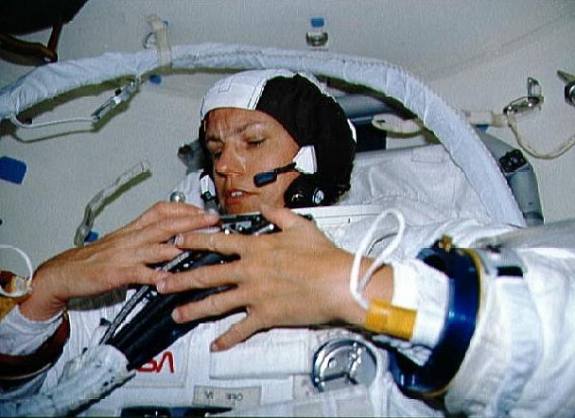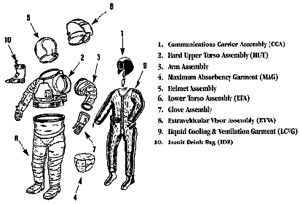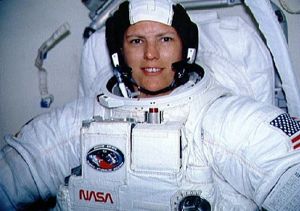
Home - Search - Browse - Alphabetic Index: 0- 1- 2- 3- 4- 5- 6- 7- 8- 9
A- B- C- D- E- F- G- H- I- J- K- L- M- N- O- P- Q- R- S- T- U- V- W- X- Y- Z
Shuttle EMU

STS-31
STS-31 Mission Specialist (MS) Sullivan dons EMU in OV-103's airlock
Credit: NASA
Status: operational 1980. Gross mass: 65 kg (143 lb).
Many variants were fabricated over the years. The suit was certified for eight EVA's, and its modular design allowed it to fit 90% of the male/female population. It featured an integrated hard torso with a portable life support system, RF sealed bladder, fabric mobility joint elements, waist bearing, and improved pressure gloves.
The EMU was designed only for the zero-G EVA function and utilized the upper body for mobility. It was not designed to provide a backup in case of loss of cabin pressure or protection on bailout. It was also not appropriate for surface operations on the Moon or Mars.
The bulky Shuttle EMU consisted of 14 layers. The first was a liner of Nylon tricot over which was a layer of spandex fabric laced with plastic tubing. These made up a liquid-cooling-and-ventilation garment. Next was a bladder and restraint layer with a pressure bladder of urethane-coated nylon and fabric layer of pressure-restraining Dacron. Above this was a liner of Neoprene coated Nylon Ripstop. This was followed by a seven-layer thermal micrometeoroid garment of aluminized Mylar, laminated with Dacron scrim. The outer layer of the suit was made of Ortho-Fabric which consisted of a blend of Gortex, Kevlar, and Nomex. The Shuttle EMU suit weighed 50 kg and its PLSS Portable Life Support System, 15 kg. It provided life support for up to nine hours.
Official ILC Dover Descriptions
The Shuttle Space Suit Assembly
0n July 20, 1969, as the world watched in awe when Neil Armstrong made his "One Small Step For A Man" onto the lunar surface, a small engineering company located in Dover, Delaware was beaming with pride. That company was ILC Dover, and the pride felt at ILC was surely justified; they designed and manufactured the space suit astronaut Armstrong wore while making American history on the moon. That same pride was sustained throughout all fifteen Skylab and Apollo/Soyuz Test Project (ASTP) mission, during which ILC produced space suits performed flawlessly. It was of little wonder then, that in 1977 ILC Dover, as part of the Hamilton Standard team, was selected by NASA as Space Suit Assembly (SSA) contractor for the Space Shuttle program.
The MC Shuttle space suit was a pressure retention structure that, together with a life support system provided a life-sustaining environment, which protected the astronaut against the hazards of space. Such hazards include a vacuum environment, temperature extremes of -180 to +277 degrees Fahrenheit, and the impact of micrometeoroids and orbital debris. Unlike the space suits used in the Apollo or Skylab Programs, where the entire suit was custom manufactured for a specific astronaut, the Shuttle suit was comprised of separate components which could be assembled to make space suits to fit almost anyone (male and female). Several sizes of each component were manufactured and placed on the shelf for future use. When needed, the components were selected from the shelf (depending on the astronaut's size) and assembled into a complete space suit. The SSA and the Life Support System (LSS), when combined, become the Extravehicular Mobility Unit, or EMU. The EMU was used for all Shuttle program extravehicular space activities. The SSA was designed and had been tested for an eight-year operational life. The design permitted low torque body movements required for performance of tasks in space.
When pressurized, the "soft" material portion of the suit became very rigid and nearly impossible to bend except where specially designed joints were provided. Such was the case when you inflate the inner tube of an automobile fire.
The tube became very stiff and was difficult to twist or bend. Without these joints it would be virtually impossible for the astronaut to do useful work. These special joints were located at the knees, wrists, shoulders, elbows, ankles, thighs and waist of the SSA. Normal body movements by the astronaut cause the suit joints to bend. This flexibility permitted the astronaut to conserve energy, reduce fatigue and to work for long periods of time.
A typical cross-section of the SSA was 11 layers deep, consisting of the Liquid Cooling & Ventilation Garment (LCVG) (2 layers); pressure garment (2 layers); and the Thermal Micrometeoroid Garment (TMG) (7 layers). Simply stated, the LCVG maintained astronaut comfort, the pressure garment provided containment of the breathing air, and the TMG protected against the micrometeoroids which hit the suit, and insulated the astronaut from the extreme temperatures of space.
Communications Carrier Assembly (CCA)
The Communications Carrier was a skull cap that interfaced with the Electrical Harness Assembly. It contained a microphone and earphones for voice communications. The skull cap was made of Teflon and nylon/lycra fabrics.
Hard Upper Torso Assembly (HIT)
The Hard Upper Torso was a vest-like rigid fiberglass shell which incorporated provisions for Arm, LTA and Helmet attachment. A Water Line and Vent Tube Assembly was fastened to the shell interior and interfaced with he LCVG and the Life Support System (LSS). The main portion of the LSS, containing water and oxygen storage and circulation provisions, mounted on the back of the HUT, while the LSS controls mounted on the front within easy reach of the astronaut.
Arm Assembly
The Arm interfaced with the HUT by a ring that retained the Arm Scye Bearing in the HUT opening. The upper and lower arm joints were separated by an arm bearing, which allowed lower arm rotation, the lower arm also provided for sizing adjustments and for quick connect/disconnect of the glove via a wrist disconnect.
The Maximum Absorbency Garment was worn under the LCVG and provided for hygienic collection, storage, and eventual transfer of astronaut urine and feces discharged during extravehicular activities.
Helmet Assembly
The Helmet Assembly consisted of a transparent Shell, Neck Ring, Vent Pad, Purge Valve, and an adjustable Valsalva device. The Helmet was secured to the HUT and provided an unobstructed field of vision. Optical clarity of the transparent shell was made possible by the use of rugged, impact resistant polycarbonate material. A vent assembly, bonded to the inside rear of the polycarbonate shell, served to diffuse the incoming gas over the astronaut's face.
Lower Torso Assembly
The Lower Torso Assembly consisted of an integrated Body Seal Closure, Waist, Waist Bearing, Leg, Thigh, Knee and Ankle joints, plus Boots. The LTA enclosed the lower body and interfaced with the HUT via the body seal closure. The flexible waist section and waist bearing afford the astronaut a large degree of movement about the waist, e.g. bending and hip rotation.
Glove Assembly
The Glove was made up of a restraint and bladder encased in a TMG. The gloves protect the astronaut's wrists and hands and were attached to the arms at the wrist disconnects. The gloves incorporated a rotary bearing to allow wrist rotation, a wrist joint to provide flexion/extension, fabric joints for thumbs and fingers, plus a hot pad for protection of the hand from extreme hot and cold extravehicular conditions. The glove included fingertip heaters that were controlled by the astronaut.
Extravehicular Visor Assembly (EVVA)
The Extravehicular Visor Assembly was a light-and-heat-attenuating shell which fit over the Helmet Assembly. It was designed to provide protection against micrometeoroid activity and accidental impact damage, plus protected the crewmember from solar radiation. A special coating gave the sun visor optical characteristics similar to those of a two-way mirror; it reflected solar heat and light, yet permitted the astronaut to see. Adjustable eyeshades may be pulled down over the visor to provide further protection against sunlight and glare.
Liquid Cooling & Ventilation Garment (LCVG)
The liquid Cooling & Ventilation Garment was a close-fitting undergarment covering the body torso and limbs. It incorporated a network of fine tubing that was maintained in close contact with the astronaut's skin by an outer layer of stretchable open fabric. The space suit was so well insulated that normal body heat maintained warmth, except for occasional cold hands, even on the cold, dark side of the spacecraft. However, cooling was required, therefore, water was circulated through the LCVG tubing to remove excess body heat. Water flowed through the various inlet and return tubes and must be uninterrupted in order for the garment to be effective. The LCVG also used ventilation ducting to return vent flow from the body extremities to the EMU Life Support System (LSS).
In-suit Drink Bag (IDB)
The IDB was a sealed bag that came in two sizes, holding 21 oz. and 32 oz. of potable (drinking) water. The bag was secured by Velcro to the inside front of the HUT. Water was readily accessible to the astronaut through a mouthpiece located at the top of the bag.
Since 1947, ILC had been active in the development of products for both government and industry. Then as today, most A C products were comprised of soft goods materials - our primary area of expertise. Today, ILC's products fall into six primary groups:
- Space Suits and Equipment
- Environmental Protection Products
- Individual and Collective Protection Equipment
- High Technology Inflatables
- Camouflage, Concealment, and Deception
- Human Engineered Composites
WARDROBE FOR THE SPACE SHUTTLE ERA
Astronauts of the space shuttle era had more than one wardrobe for space flight and what they wear depended on the job they were doing. During ascent and entry, each crewmember wore special equipment consisting of a partial pressure suit, a parachute harness assembly, and a parachute pack. The suit, consisting of helmet, communication assembly, torso, gloves and boots, provided counter-pressure and anti-exposure functions in an emergency situation in which the crew must parachute from the orbiter, The suit had inflatable bladders that fill it with oxygen from the orbiter. These bladders inflated automatically at reduced cabin pressure. They also could be manually inflated during entry to prevent the crewmember from blacking out. Without the suit pressing on the abdomen and the legs, the blood would pool in the lower part of the body and cause a person to black out as the spacecraft returned from microgravity to Earth's gravity. The partial-pressure suit and equipment would support a crewmember for a 24-hour period in a life raft in case of an egress over water.
Working Inside the Space Shuttle
During orbit, astronauts work inside the space shuttle in shirtsleeve comfort. Prior to a mission, crew members were outfitted from a selection of clothing including flight suits, trousers, lined zipper jackets, knit shirts, sleep shorts, soft slippers, and underwear. The materials of every component of the clothing were flame retardant. Covering the exterior of the garments were closable pockets for storing such items as pens, pencils, data books, sunglasses, a multipurpose Swiss army pocket-knife, and scissors.
Working Outside the Space Shuttle
To work in the open cargo bay of the space shuttle or in space, astronauts wear the shuttle extravehicular mobility unit (EMU) spacesuit, which was developed to be More durable and more flexible than previous spacesuits were. The suit was modular in design, with many interchangeable parts. The upper torso, lower torso, arms, and gloves were manufactured in different sizes and could be assembled for each mission in combinations needed to fit men and women astronauts. This design was cost-effective because the suits were reusable and not custom fitted as were spacesuits used in previous NASA manned space flight programs.
Suiting up
The EMU comprised the spacesuit assembly, the primary life support system (PLSS), the display and control module, and several other crew items designed for spacewalks and emergency life support. The EMU accommodates a variety of interchangeable systems that interconnect easily and securely in single-handed operation for either normal or emergency use. When preparing to work in space, the astronaut went into the airlock of the space shuttle orbiter and put on the following parts of the EMU:
- A urine-collection device that receives and stores urine for transfer later to the orbiter waste management system.
- A liquid cooling and ventilation garment, a one-piece mesh suit made of spandex, zippered for front entry, and weighing 6.5 pounds dry. The garment had water-cooling tubes running through it to keep the wearer comfortable during active work periods.
- An in-suit drink bag containing 21 ounces of potable water, the "Snoopy Cap," or communications carrier assembly, with headphones and microphones for two-way communications and caution-and-warning tones, and a biomedical instrumentation subsystem.
All fabric-to- hardware connections were made with either mechanical joints or adhesive bonding. Materials used in the construction of the suit were selected to prevent fungus or bacteria growth; however, the suit Must be cleaned and dried after flight use. The entire suit assembly was rated with a minimum 8-year life expectancy. The nominal operating atmospheric pressure in the suit was 4.3 psia. The suit comprised several layers including a polyurethane-coated nylon pressure bladder, a polyester structural restraint layer with folded and pleated joints (for mobility), and a woven Kevlar, Teflon, and Dacron anti-abrasion outer layer.
The maximum total weight of the largest size spacesuit assembly, including the liquid cooling and ventilation garment, urine collection device, helmet and visor assembly, communications carrier assembly, in-suit drink bag, and biomedical instrumentation subsystem, was 107 pounds,
The astronaut was ready to go to work in space and secured the necessary tools to the mini-workstation of the suit. The EMU lights were mounted on the helmet and were a necessity because during orbital operations approximately every other 45 minutes were spent in darkness.
Communications
An electrical harness inside the suit connected the communications carrier assembly and the biomedical instrumentation equipment to the hard upper torso where internal connections were routed to the extravehicular communicator by means of a pass-through.
The extravehicular communicator attached to the upper portion of the life support system at the back of the hard upper torso, The controls were located on the display and control module mounted on the chest at the front of the upper torso. The extravehicular communicator provided radio communication between the suited crewmember and the orbiter. In addition, electrocardiographic (EKG) information was telemetered through the extravehicular communicator to the orbiter and to flight surgeons in the Mission Control Center at Houston, Texas.
The radios for spacewalk communications had two single UHF channel transmitters, three single channel receivers, and a switching mechanism. These backpack radios had a "low profile" antenna - a foot-long rectangular block fitted to the top of the PLSS. The radios weigh 8.7 pounds and were 12 inches long, 4.3 inches high, and 3.5 inches wide.
Primary life support system The PLSS consisted of a backpack unit permanently mounted to the hard upper torso of the suit and a Control-and-display unit mounted on the suit chest. The backpack unit supplied oxygen for breathing, suit pressurization, and ventilation. The unit also cooled and circulated water used in the liquid cooling ventilation garment, controlled ventilation gas temperature, absorbed carbon dioxide, and removed odors from the suit atmosphere. The secondary oxygen pack attached to the bottom of the PLSS and supplied oxygen if the primary oxygen fails. The control-and-display unit allowed the crewmember to control and monitor the PLSS, the secondary oxygen pack, and, when attached, the manned maneuvering unit.
| ISS EMU American space suit, operational 1993. Upgraded version of the Shuttle EMU with improved sizing and mobility, 25 EVA certification, Hamilton Standard and ILC Dover. |
Family: Space Suits. Country: USA. Agency: NASA, ILC Dover. Bibliography: 489.
 | Diagram of Shuttle E Credit: ILC Dover |
 | STS-31 STS-31 MS Sullivan wearing EMU prepares for contingency EVA in OV-103 airlock Credit: NASA |
Back to top of page
Home - Search - Browse - Alphabetic Index: 0- 1- 2- 3- 4- 5- 6- 7- 8- 9
A- B- C- D- E- F- G- H- I- J- K- L- M- N- O- P- Q- R- S- T- U- V- W- X- Y- Z
© 1997-2019 Mark Wade - Contact
© / Conditions for Use